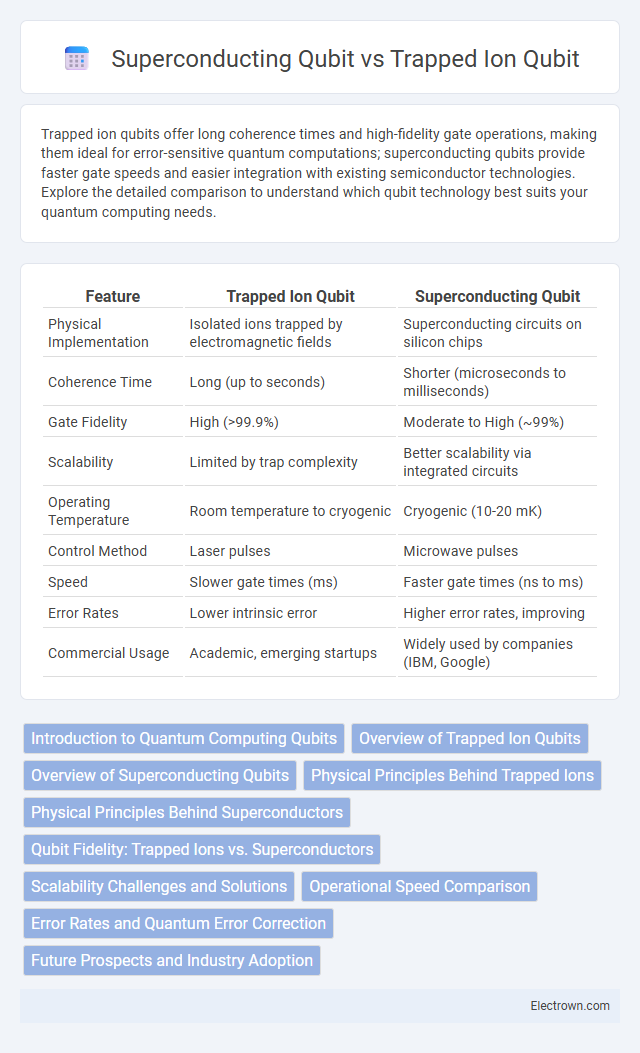Trapped ion qubits offer long coherence times and high-fidelity gate operations, making them ideal for error-sensitive quantum computations; superconducting qubits provide faster gate speeds and easier integration with existing semiconductor technologies. Explore the detailed comparison to understand which qubit technology best suits your quantum computing needs.
Table of Comparison
| Feature | Trapped Ion Qubit | Superconducting Qubit |
|---|---|---|
| Physical Implementation | Isolated ions trapped by electromagnetic fields | Superconducting circuits on silicon chips |
| Coherence Time | Long (up to seconds) | Shorter (microseconds to milliseconds) |
| Gate Fidelity | High (>99.9%) | Moderate to High (~99%) |
| Scalability | Limited by trap complexity | Better scalability via integrated circuits |
| Operating Temperature | Room temperature to cryogenic | Cryogenic (10-20 mK) |
| Control Method | Laser pulses | Microwave pulses |
| Speed | Slower gate times (ms) | Faster gate times (ns to ms) |
| Error Rates | Lower intrinsic error | Higher error rates, improving |
| Commercial Usage | Academic, emerging startups | Widely used by companies (IBM, Google) |
Introduction to Quantum Computing Qubits
Trapped ion qubits use ions confined by electromagnetic fields, offering long coherence times and high-fidelity quantum gates ideal for precise quantum computing. Superconducting qubits leverage Josephson junctions to create energy states in superconducting circuits, enabling faster gate operations but often facing shorter coherence times. Your choice between these depends on whether you prioritize coherence stability from trapped ions or gate speed and scalability from superconducting qubits.
Overview of Trapped Ion Qubits
Trapped ion qubits utilize individual ions confined by electromagnetic fields and manipulated using laser pulses, offering exceptional coherence times and high-fidelity gate operations. Their uniformity and isolated nature reduce decoherence, making them ideal for precision quantum computations and error correction. Your quantum system benefits from their long coherence and precise control, distinguishing them from superconducting qubits that rely on macroscopic electrical circuits.
Overview of Superconducting Qubits
Superconducting qubits leverage circuits made from superconducting materials cooled to near absolute zero, allowing them to exhibit quantum behavior such as superposition and entanglement. These qubits benefit from relatively fast gate speeds and easier integration with existing semiconductor fabrication methods, making them prominent in current quantum computing research. Your quantum computing applications may gain from their scalability and compatibility with microwave control techniques, setting them apart from trapped ion qubits.
Physical Principles Behind Trapped Ions
Trapped ion qubits operate based on the precise control of charged atomic ions held in electromagnetic fields, allowing for long coherence times and high-fidelity quantum gate operations. Laser pulses manipulate the ions' internal electronic states and motional modes, enabling robust qubit initialization, manipulation, and readout. Your quantum system benefits from the exceptional stability and controllability inherent in trapped ion physical principles, distinguishing it from superconducting qubit architectures.
Physical Principles Behind Superconductors
Superconducting qubits operate based on the principles of superconductivity, where electrons pair up to form Cooper pairs that move without electrical resistance below a critical temperature. This phenomenon allows the creation of macroscopic quantum states in Josephson junction circuits, enabling coherent quantum information processing. Unlike trapped ion qubits that manipulate individual ions using electromagnetic fields, superconducting qubits leverage macroscopic quantum effects in solid-state materials to achieve fast gate operations and scalability.
Qubit Fidelity: Trapped Ions vs. Superconductors
Trapped ion qubits demonstrate higher intrinsic qubit fidelity, often exceeding 99.9%, due to their well-isolated atomic states and minimal decoherence from environmental noise. Superconducting qubits typically have fidelities around 99%, constrained by material defects and flux noise, though ongoing advancements aim to bridge this gap. The superior coherence times and precise quantum gate implementations in trapped ions enable more reliable quantum computations compared to current superconducting qubit technologies.
Scalability Challenges and Solutions
Trapped ion qubits face scalability challenges due to complex laser control and slower gate speeds that complicate large-scale integration, whereas superconducting qubits benefit from faster gate operations but struggle with qubit coherence and crosstalk in dense circuits. Solutions for trapped ions include advanced photonic interconnects and segmented ion traps enabling modular architectures, while superconducting qubits leverage 3D integration and error correction codes to enhance scalability. Both platforms continue to innovate control techniques and materials to overcome fundamental physical limitations and improve quantum processor size and fidelity.
Operational Speed Comparison
Trapped ion qubits typically operate with gate speeds in the microsecond range, whereas superconducting qubits achieve much faster gate operations on the order of nanoseconds. This significant difference in operational speed impacts the overall computational speed and scalability of quantum processors. Optimizing your quantum system's performance requires balancing the ultrafast gate speeds of superconducting qubits with the high coherence times offered by trapped ion qubits.
Error Rates and Quantum Error Correction
Trapped ion qubits exhibit lower error rates due to their longer coherence times and precise quantum gate operations, making them highly suitable for implementing quantum error correction protocols. Superconducting qubits, while faster in gate operation, suffer from higher error rates driven by decoherence and noise, requiring more frequent error correction cycles to maintain fidelity. Your choice between trapped ion and superconducting qubits will depend on balancing gate speed and error resilience to optimize quantum error correction performance.
Future Prospects and Industry Adoption
Trapped ion qubits offer superior coherence times and high-fidelity operations, positioning them as strong candidates for scalable quantum computing in precision-sensitive industries. Superconducting qubits benefit from faster gate speeds and extensive industry adoption, with significant investments from major tech companies accelerating their commercialization. Your choice between these technologies depends on whether you prioritize long-term stability and accuracy or rapid industrial integration and scalability.
trapped ion qubit vs superconducting qubit Infographic

 electrown.com
electrown.com